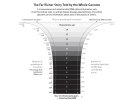Hi Laura,
Very good to connect, thank you for this reply.
Keep in mind here that Stringer's comment "...new genetic data have emerged to show that we
Homo sapiens are
not purely derived from a recent African origin", refers only to him eventually accepting the fact that modern humans have archaic DNA, largely from Neanderthals. It took him a very long time to even make this small concession. He still places all of the events leading to modern humans squarely in Africa - he has indicated he might be open to Western Asia playing some role in the story but that is it for him at most.
Stronger now advocated multiregionalism, but only with different regions of Africa.
When it comes to archaic hominin DNA you make a great observation about the way the modern human genome has selected against DNA from archaic humans such as Neanderthals. We really do not know how much of the human genome was Neanderthal material 50,000 years ago, to say we are 2-3% Neanderthals gives the misleading impression that no much mixing occurred - we really do not know that at all as so much material may have been selected against over that time.
Humans seem to go back at least 3 million years in a form readily recognisable to us, before that we might struggle to see them as anything other than another primate relative. But then, we really do not know if we have found any fossils from our ancestors beyond 3 million years ago, scientists are growing more sceptical about this and many doubt Australopithecus is a direct ancestral genus to
Homo. We may simply not have found any fossils from humans much beyond the era of Homo erectus and Homo habilis - perhaps they looked pretty much like these species. I made a very different argument in my book, suggesting Australopithecus were perhaps early Homo, I would remove that in a future edition.
It does seem that our ancestors lived by the mantra of "If it ain't broke, don't fix it." We can assume either what they had was sufficient for their needs and wants, they had other technology that has not survived in the archaeological record or they lacked mental dexterity to move beyond the tools they had conjured up. This raises the question of why they then did change tool technology, either the situation conspired to bring about new needs or their brains changed in some significant way and they were able to think in new directions. Could this be deliberate upgrades by external forces (such as a meddling ET visitor)? I rather suspect you are correct though, that stone tech was "just a small aspect of their reality" we just can't know what else they were doing/using.
Laura said:
There seem to be a lot of clues in Cremo's book and I'll get back to reviewing it again soon; I want to get all the stuff that mainstream and off-to-the side mainstream are saying right now. At some point, if I live that long, I'll start assembling the data, point, counterpoint, and see if I can make sense of it. Right now, it's just in my head and in the notes, I write here on the forum.
It is interesting you mention Cremo's book, I have had it flagged t me many times over the years, and again since publishing the book. I finally downloaded a pdf version a couple of weeks ago and skimmed it to get a feel for the sources he uses. What I noticed right away was that despite being published in 1993, almost every source he used came from research done between 1800 - 1950, a period on which there was wild speculation by fantasists passing for scientists, mostly ideologically driven racists and religious nuts, all sharing from the same lack of meaningful training and absence of scientific dating methods. That Cremo chose to base his 1993 boo on these out of date and spurious reports suggests he was agenda driven. He could have referred to work carried out between 1980 and 1993 and I would excuse him, we have to conclude he wanted to use wacky reports that made wild baseless claims and these mostly exist if you look back 100 years or so. As you know, I did everything possible to use entirely cutting-edge studies, I did not try to build a case from long-abandoned models and speculations. I consider Cremo's book worthless on this basis and entirely written to support his stated Hindu beliefs. This is sad because that book is so revered and very often promoted to be the best in the field of non-academic human origins research!
I have read material from Alan Thorne and Xinzhi Wu on-line and will look for some good articles or papers, certainly, comments from Wu have appeared regularly in the recent press concerning controversial finds of modern human fossils in China. China is offering some of the best finds and it is there we are seeing the death of recent out of Africa being hastened most rapidly, at least in conjunction with Australia perhaps.
Hope some of this is useful!
Moderator Edit: Placed Laura's text in quotes.

